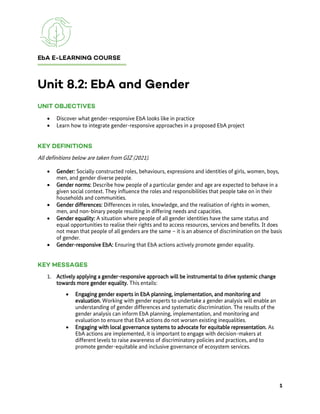Unit_8.2_Handout.pdf
- 1. âĒ Discover what gender-responsive EbA looks like in practice âĒ Learn how to integrate gender-responsive approaches in a proposed EbA project All definitions below are taken from GIZ (2021). âĒ Gender: Socially constructed roles, behaviours, expressions and identities of girls, women, boys, men, and gender diverse people. âĒ Gender norms: Describe how people of a particular gender and age are expected to behave in a given social context. They influence the roles and responsibilities that people take on in their households and communities. âĒ Gender differences: Differences in roles, knowledge, and the realisation of rights in women, men, and non-binary people resulting in differing needs and capacities. âĒ Gender equality: A situation where people of all gender identities have the same status and equal opportunities to realise their rights and to access resources, services and benefits. It does not mean that people of all genders are the same â it is an absence of discrimination on the basis of gender. âĒ Gender-responsive EbA: Ensuring that EbA actions actively promote gender equality. 1. Actively applying a gender-responsive approach will be instrumental to drive systemic change towards more gender equality. This entails: âĒ Engaging gender experts in EbA planning, implementation, and monitoring and evaluation. Working with gender experts to undertake a gender analysis will enable an understanding of gender differences and systematic discrimination. The results of the gender analysis can inform EbA planning, implementation, and monitoring and evaluation to ensure that EbA actions do not worsen existing inequalities. âĒ Engaging with local governance systems to advocate for equitable representation. As EbA actions are implemented, it is important to engage with decision-makers at different levels to raise awareness of discriminatory policies and practices, and to promote gender-equitable and inclusive governance of ecosystem services.
- 2. âĒ Allocating resources for inclusive participatory processes. To ensure meaningful and inclusive participation, resources should be channelled to groups that are typically excluded from EbA planning and implementation processes, such as women and Indigenous communities. âĒ Creating opportunities for women to take on leadership roles. Leaders of EbA planning processes and projects must actively work to create leadership roles for women and opportunities for meaningful engagement, as EbA actions should actively be engaging with and lifting the voices of underrepresented groups. âĒ Toward Gender-Responsive Ecosystem-based Adaptation. Why itâs needed and how to get there (by Angie DazÃĐ and Anika Terton, for GIZ, 2021). The report provides a rationale for integrating gender considerations in EbA action from both a policy and a practical perspective. It outlines what gender-responsive EbA looks like in practice, followed by case examples. âĒ Building Resilience with Nature and Gender in the Eastern Caribbean: A Toolkit to Mainstream Ecosystem-Based Adaptation, Gender Equality & Social Inclusion (by Annie Bonnin Roncerel et al., for the Organisation of Eastern Caribbean States, 2020). This toolkit provides an overview of EbA and gender equality and social inclusion issues, along with guidance on mainstreaming EbA and gender in resilience building. âĒ Climate Vulnerability and Capacity Analysis (CVCA) Handbook: Informing Community-Based Adaptation, Resilience and Gender Equality (by Angie DazÃĐ, AurÃĐlie Ceinos and Karl Deering, for CARE International, 2019). With a focus on gender equality, ecosystems, and inclusive governance, this handbook from CARE International provides guidance for participatory analysis of vulnerability to climate change and adaptive capacity at the community level. âĒ Toolkit for a Gender-Responsive Process to Formulate and Implement NAPs (by Angie DazÃĐ and Clare Church, for the NAP Global Network, 2019). This toolkit was developed in collaboration with the Adaptation Committee and the Least Developed Countries Expert Group under the UNFCCC as a supplement to the UNFCCC Technical Guidelines for the NAP process. It provides guidance on integrating gender considerations throughout all the steps and enabling activities of the NAP process. âĒ From Guiding Principles to Action: Integrating a Gender Responsive and Social Inclusive Approach Into Shared Resources, Joint Solutions (SRJS) Strategies and Results (by the IUCN Global Gender Office (GGO), for its SRJS initiative, 2017). This document provides guidance on context analysis and design of activities and indicators with a gender-responsive and socially inclusive approach. Though not focused on climate change adaptation, the process could inform EbA initiatives. âĒ Adaptation, Livelihoods and Ecosystems (ALivE) Planning Tool (by UNEP, the Global Environment Facility, IISD, IUCN and UNEPâs International Ecosystem Management Partnership (UNEP-IEMP)). ALivE is a computer-based EbA planning tool that can be used to understand and analyse the linkages among ecosystems, livelihoods, and climate change and plan effective EbA solutions. DazÃĐ, A. Ceinos, A., & Deering, K. (2019). Climate Vulnerability and Capacity Analysis Handbook Version 2.0. CARE Climate Change and Resilience Platform. https://careclimatechange.org/wp- content/uploads/2016/06/CARE-CVCA-Handbook-EN-v0.8-web.pdf
- 3. DazÃĐ, A. & Church, C. (2019). Toolkit for a Gender-Responsive Process to Formulate and Implement National Adaptation Plans (NAPs). International Institute for Sustainable Development (IISD). https://napglobalnetwork.org/resource/toolkit-for-gender-responsive-national-adaptation-plans/ DazÃĐ, A. & Terton, A. (2021). Toward gender-responsive Ecosystem-based Adaptation: Why it's needed and how to get there. Deutsche Gesellschaft fÞr Internationale Zusammenarbeit (GIZ) GmbH. https://www.adaptationcommunity.net/wp-content/uploads/2021/07/Toward-gender-responsive- EbA.pdf International Institute for Sustainable Development (IISD). (2016). ALivE â Adaptation Livelihoods and Ecosystems Planning Tool. https://www.iisd.org/projects/alive-adaptation-livelihoods-and-ecosystems-planning- tool Roncerel, A. B., Perch, L., McCue, J., & Zermoglio, F. (2020). Building Resilience with Nature and Gender in the Eastern Caribbean â A toolkit to Mainstream Ecosystem-based Adaptation Gender Equality and Social Inclusion. Organisation of Eastern Caribbean States (OECS). https://drive.google.com/file/d/1qT84dEEb9Q1CJydJ0oJa9DcrunlBRxtg/view



